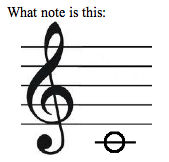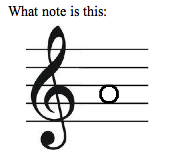General Music Trivia Questions! Quiz
-
How many beats does a quarter note get in 4/4 time?
-
1 beat
-
2 beats
-
3 beats
-
4 beats
-
Explore the fundamentals of music with the 'General Music Trivia Questions! Quiz'. This quiz assesses knowledge of musical notation, dynamics, and historical practices in music theory, perfect for learners looking to understand basic musical concepts.

- 2.
What does this symbol mean in music?
-
Play it fast.
-
Play it loud.
-
Play it well.
-
Play it sweetly.
Correct Answer
A. Play it loud.Explanation
The symbol in music indicates that the piece should be played loudly. This instruction is often represented by the symbol "f" which stands for forte, meaning strong or loud in Italian. It directs the musician to increase the volume and intensity of their performance.Rate this question:
-
- 3.
This symbol is called a ___________ clef.
Correct Answer
trebleExplanation
The symbol mentioned in the question is commonly known as a treble clef. It is used in musical notation to indicate that the notes written on the staff are to be played or sung in a higher range. The treble clef is characterized by its swirling shape, with the center of the spiral indicating the position of the note G above middle C. It is primarily used for instruments such as the piano, violin, and flute, as well as for higher-pitched voices in vocal music.Rate this question:
- 4.
The _____________ ______________________ tells you how many beats are in each measure.
Correct Answer
time signatureExplanation
The time signature is a musical notation that consists of two numbers stacked on top of each other. The top number indicates the number of beats in each measure, while the bottom number represents the type of note that receives one beat. Therefore, the time signature tells you how many beats are in each measure.Rate this question:
- 5.
Dynamic markings indicate
-
Volume
-
Speed
-
Short or long
-
Connected and disconnected
Correct Answer
A. VolumeExplanation
Dynamic markings indicate the level of volume in a musical piece. They provide instructions to the performer on how loud or soft to play the music. By using dynamic markings such as pianissimo (very soft), piano (soft), mezzo piano (moderately soft), mezzo forte (moderately loud), forte (loud), and fortissimo (very loud), composers can convey the desired intensity and expression of the music.Rate this question:
-
- 6.
Directions in music are given in Italian because
-
Italian people make the best musicians.
-
Italian people are very smart.
-
Most early schools for writing music were in Italy.
-
Everyone is 1600 spoke Italian.
Correct Answer
A. Most early schools for writing music were in Italy.Explanation
The correct answer is "Most early schools for writing music were in Italy." This is because Italy has a rich history in music and was the birthplace of many influential composers and musicians. During the Renaissance and Baroque periods, Italy was a hub for musical innovation, and many of the first music schools were established there. As a result, Italian became the language commonly used for musical directions and terminology.Rate this question:
-
- 7.
The structure of the music
-
Style
-
Form
-
Beat
-
Pitch
Correct Answer
A. FormExplanation
Form refers to the overall structure or organization of a piece of music. It determines how different sections of the music are arranged and how they relate to each other. The form of a piece can be described using musical terms such as ABA, ABAB, or verse-chorus. Understanding the form helps listeners to follow and make sense of the music, as well as appreciate the composer's intentions and choices in creating the piece.Rate this question:
-
- 8.
The speed of the beat.
-
Music
-
Instrumentation
-
Tempo
-
Form
Correct Answer
A. TempoExplanation
Tempo refers to the speed at which a musical piece is played. It determines the overall pace and feel of the music. Different tempos can evoke different emotions and moods in the listener. The speed of the beat is directly related to the tempo of the music. A fast tempo will have a quicker beat, while a slow tempo will have a slower beat. Therefore, tempo is the correct answer as it directly addresses the speed of the beat in relation to the music.Rate this question:
-
- 9.
Three or more stacked notes.
-
Intro
-
Music
-
Melody
-
Chord
Correct Answer
A. ChordExplanation
The given answer, "chord," is correct because the question provides a sequence of words related to music, specifically "intro," "music," "melody," and "chord." In music theory, a chord refers to the simultaneous sounding of three or more notes. Therefore, the word "chord" fits logically into the sequence as the next term, following the progression from "intro" to "music" to "melody."Rate this question:
-
- 10.
What are the letters of the English Alphabet used for writing and reading music?
-
ABCDEFG
-
GHJKGFD
-
ABCDEFGH
-
HIJKLMNOP
Correct Answer
A. ABCDEFGExplanation
The letters of the English Alphabet used for writing and reading music are ABCDEFG. These letters represent the musical notes in the Western musical notation system. Each letter corresponds to a specific pitch or note on the musical scale. By using these letters, musicians can easily communicate and notate musical compositions.Rate this question:
-
- 11.
-
THIS IS A TEMPO
-
THIS IS A STAFF
-
THIS IS A TREBLE CLEF
-
THIS IS A CANDY BAR
Correct Answer
A. THIS IS A TREBLE CLEF -
- 12.
-
THIS IS A STAFF
-
THIS IS A CLEF
-
THIS IS A MAP
-
THIS IS A KEY
Correct Answer
A. THIS IS A STAFF -
- 13.
-
THIS IS A STAFF
-
THIS IS A CLEF
-
MEASURE
-
THIS IS A BARLINE
Correct Answer
A. MEASURE -
- 14.
-
A
-
B
-
C
-
D
-
E
Correct Answer
A. C -
- 15.
-
A
-
B
-
C
-
D
-
E
Correct Answer
A. A -
- 16.
-
Whole Note
-
Half Note
-
Quarter Note
-
Eighth Note
-
Sixteenth Note
Correct Answer
A. Eighth Note -
- 17.
-
Whole Note
-
Half Note
-
Quarter Note
-
Eighth Note
-
Sixteenth Note
Correct Answer
A. Half Note -
- 18.
-
Half Note
-
Whole Note
-
Eighth Note
-
Quarter Note
Correct Answer
A. Eighth Note -
- 19.
-
Tuba
-
Harp
-
String Bass
-
Piano
Correct Answer
A. Harp -
- 20.
-
End
-
Slow Down
-
Repeat
-
Bass Clef
Correct Answer
A. Repeat -
- 21.
Which of the following are NOT good examples of excellent audience behavior?
-
Leaving and returning during the performance.
-
Texting during a show.
-
Bringing crying babies.
-
Using cell phones and not turning them off.
-
All of the above.
Correct Answer
A. All of the above.Explanation
All of the mentioned behaviors, such as leaving and returning during the performance, texting, bringing crying babies, and not turning off cell phones, are not considered good examples of excellent audience behavior. These actions can be disruptive and disrespectful to both the performers and other audience members, as they can distract from the performance and create a disturbance. It is important for audience members to be considerate and respectful of others' experiences by refraining from engaging in such behaviors.Rate this question:
-
- 22.
Piano, pianissimo, forte, and fortissimo are examples of...
-
Tempo
-
Dynamics
-
Woodwinds
-
Clefs
Correct Answer
A. DynamicsExplanation
The terms piano, pianissimo, forte, and fortissimo are all musical terms that describe the volume or intensity of a piece of music. They fall under the category of dynamics, which refers to the varying levels of loudness and softness in music. Tempo, on the other hand, refers to the speed or pace of the music. Woodwinds and clefs are unrelated to the given terms.Rate this question:
-
- 23.
A sharp in music notation will
-
Raise the current note a tone
-
Raise the current note a half step
-
Lower the current note a tone
-
Lower the current note a half step
-
Only change notes located in spaces
Correct Answer
A. Raise the current note a half stepExplanation
A sharp in music notation raises the current note a half step. This means that if a note is played on a piano or any other instrument and it is followed by a sharp symbol, the pitch of that note will be increased by one semitone or half step.Rate this question:
-
- 24.
Music written higher than middle C on the piano is written in what clef?
-
Alto
-
Tenor
-
Treble
-
Bass
-
Baritone
Correct Answer
A. TrebleExplanation
The correct answer is treble. The treble clef is used to notate higher pitches on the piano. It is often played by instruments such as the flute, violin, and right hand of the piano. The treble clef is characterized by its curly shape and is also known as the G clef, as it encircles the line representing the G above middle C.Rate this question:
-
- 25.
In 4/4 time, a half note receives
-
1 beat
-
2 beats
-
4 beats
-
1/2 beat
-
3 beats
Correct Answer
A. 2 beatsExplanation
In 4/4 time, a half note receives 2 beats. In music notation, a half note is represented by an open oval shape with a stem. In 4/4 time, there are 4 beats in each measure, and a half note takes up half of that time, hence it receives 2 beats.Rate this question:
-
- 26.
The space between two bar lines is called a
-
Tie
-
Beam
-
Measure
-
Phrase
-
Clef
Correct Answer
A. MeasureExplanation
A measure is the space between two bar lines in sheet music. It represents a specific unit of time in music, containing a set number of beats or notes. It helps musicians keep track of the rhythm and timing of a piece.Rate this question:
-
- 27.
A ___________________ is a person who writes music.
Correct Answer
composerExplanation
A composer is a person who writes music. They are responsible for creating and arranging musical compositions, including melodies, harmonies, and rhythms. Composers may work in various genres, such as classical, jazz, or pop, and their music can be performed by solo musicians, ensembles, or orchestras. They use their creativity and knowledge of musical theory to express emotions and tell stories through their compositions. Composers often collaborate with performers and producers to bring their music to life and share it with audiences.Rate this question:
- 28.
Music written below middle C in piano is written on what clef?
-
Alto
-
Treble
-
Baritone
-
Tenor
-
Bass
Correct Answer
A. AltoExplanation
The correct answer is alto because music written below middle C in piano is typically written on the alto clef. The alto clef is used for instruments such as the viola and the alto trombone, which have a lower range than instruments written in treble clef. It is important to use the correct clef to indicate the appropriate pitch range for the instrument being played.Rate this question:
-
Quiz Review Timeline (Updated): Jan 13, 2023 +
Our quizzes are rigorously reviewed, monitored and continuously updated by our expert board to maintain accuracy, relevance, and timeliness.
-
Current Version
-
Jan 13, 2023Quiz Edited by
ProProfs Editorial Team -
Jan 29, 2014Quiz Created by
Sue
 Back to top
Back to top











.png)

.png)